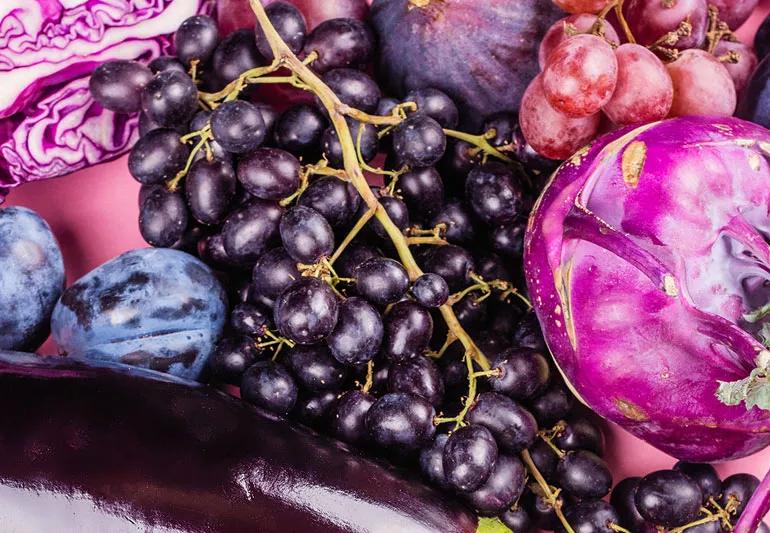Why you should explore the purple end of the food spectrum

One popular recommendation for a healthy diet is to “eat the rainbow.” This strategy highlights the importance of eating a variety of fruits and vegetables to get the nutrients you need.
Advertisement
Cleveland Clinic is a non-profit academic medical center. Advertising on our site helps support our mission. We do not endorse non-Cleveland Clinic products or services. Policy
According to dietitian Joyce Prescott, MS, RD, LD, the chemicals that give plants their bright colors can be especially good for your health. And fruits and vegetables on the purple end of the spectrum contain a chemical called anthocyanin that packs a nutritional punch.
Anthocyanins (an-tho-SY-uh-nins) are a group of deep red, purple and blue pigments found in plants. They’re part of a larger category of plant-based chemicals called flavonoids. Flavonoids are abundant in all parts of plants: fruits, seeds, shoots, flowers and leaves. They help plants reproduce by attracting pollinators and protect plants from environmental stressors like UV (ultraviolet) light, drought and cold.
“Research shows that flavonoids are also powerful nutrients and may help explain why plant-based diets are consistently associated with health benefits,” says Prescott. “We think this is due, in part, to their antioxidant properties.”
Antioxidants destroy unstable molecules called free radicals that can damage your cells. Free radicals occur naturally as a by-product of metabolism, as well as from environmental exposure to air contamination, cigarette smoke, alcohol, sunlight and harmful chemicals.
Among about 6,000 known flavonoids, there are six main types of anthocyanins:
Advertisement
Fruits, vegetables and grains with red, purple, blue or black hues tend to be rich in anthocyanins. Berries have the highest levels, particularly black elderberries and aronia berries (chokeberries). Blueberries, blackberries, raspberries and strawberries are also great sources. Additional foods with a high anthocyanin punch include:
“Fresh and frozen forms of the foods listed retain the highest levels of this colorful flavonoid,” notes Prescott. “You’ll also find many types of anthocyanin-containing supplements. Extracts of elderberry, aronia, tart cherry and blueberry are just a few that have become popular.”
Anthocyanin-rich foods are an important part of a healthy diet. But researchers are still investigating their role in treating and preventing specific diseases. Overall, evidence suggests that anthocyanins may provide a range of health benefits.
Here are some of the latest findings:
Anthocyanins may help reduce blood pressure, according to a review of 66 studies. Study participants with hypertension took a variety of extracts and preparations from anthocyanin-containing plants. The study found there was a consistent lowering effect on blood pressure. In other studies, however, researchers identified many factors that led to mixed results, such as:
This study highlights the need for more research to establish a dosing regimen and determine who might benefit from anthocyanins.
Atherosclerosis is when plaque builds up on the inside of your arteries. This buildup can cause high blood pressure, heart attack, stroke, peripheral artery disease or kidney failure.
The formation of plaque is a multi-stage process that depends on many factors. Prescott says that research shows that anthocyanins can intervene at different stages in the process by reducing:
Advertisement
Research shows that anthocyanins can help protect and improve your brain function:
Researchers believe that anthocyanins’ antioxidant and anti-inflammatory properties are responsible for these improvements.
Anthocyanins may act in many ways to slow or stop cancer. Studies suggest that anthocyanins might:
However, Prescott cautions that the research on anthocyanins and cancer has mainly happened in the laboratory. There are only limited data from clinical trials on people. Researchers need to continue to investigate these findings so they can determine exactly how anthocyanins affect cancer growth and treatment.
While the results of many of these studies are promising, they don’t offer clear guidance on how much anthocyanin you should consume each day. Unlike essential vitamins and minerals, there isn’t a daily recommended value.
Advertisement
“Your best strategy is to include anthocyanin-rich foods as part of your regular meal pattern,” says Prescott. “We know these foods are safe and can help boost your overall nutrition.”
There’s no clear evidence supporting the use of anthocyanin supplements. While supplements are widely available and claim many health benefits, data guiding the use of these products is generally nonexistent.
Prescott recommends talking to your healthcare provider if you’re considering taking an anthocyanin supplement. It’s important to make sure the supplement won’t interfere with your current medications. Your healthcare provider can also help you decide if a supplement is the right choice based on your health and medical history.
Advertisement
Learn more about our editorial process.
Advertisement

High in antioxidants and vitamins B9, C and K, cauliflower helps fight illness, strengthens bones, and protects your liver and gut

Nutrients, antioxidants and water in celery help your heart and gut while keeping you hydrated

When popped right, its nutrients can help protect against obesity, cancer, heart disease and dementia

This leafy green can boost digestion and eye health, remove toxins and fight cancer and inflammation

Black currants are small but mighty — rich in nutrients that can boost heart health, fight inflammation and protect your eyes

This trace mineral is essential and easy to get from your diet

This ancient algae antioxidant is good for your heart, mouth and more

Avocados, cheese and nuts are high in calories but have big health benefits

If you’re feeling short of breath, sleep can be tough — propping yourself up or sleeping on your side may help

If you fear the unknown or find yourself needing reassurance often, you may identify with this attachment style

If you’re looking to boost your gut health, it’s better to get fiber from whole foods